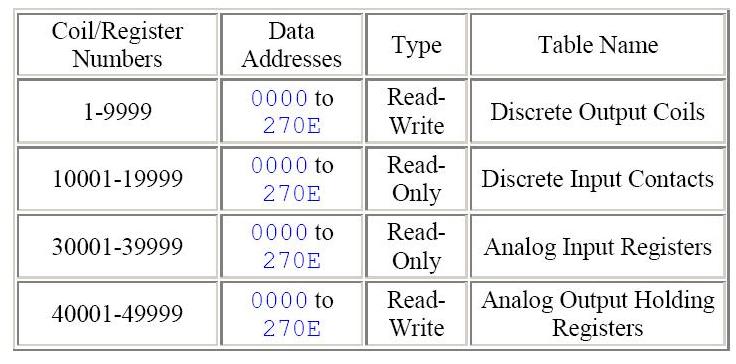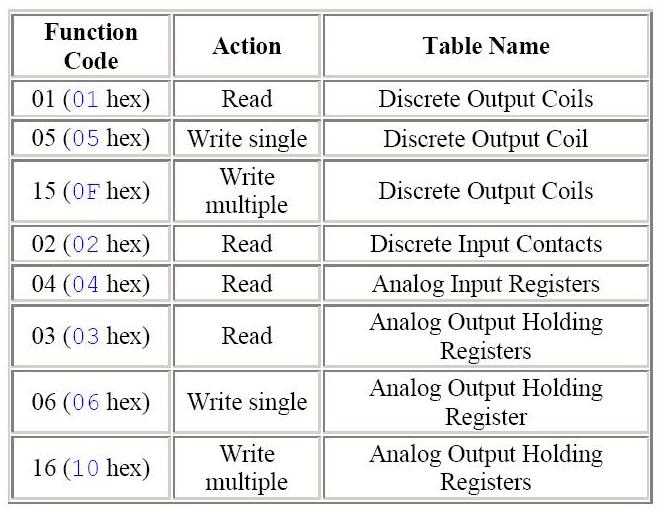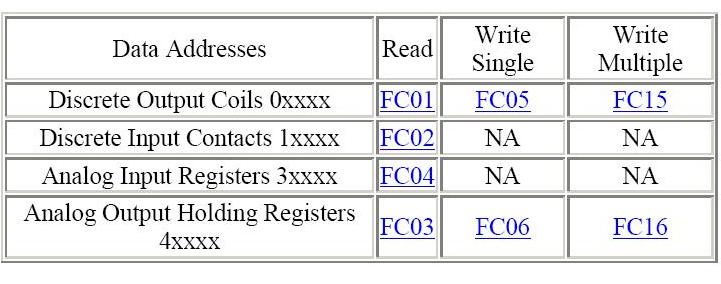How Modbus Works
From: https://www.se.com/us/en/faqs/FA168406/
What is Modbus and How does it work?
What is Modbus?
Modbus is a serial communication protocol developed by Modicon published by
Modicon® in 1979 for use with its programmable logic controllers (PLCs).
In simple terms, it is a method used for transmitting information over
serial lines between electronic devices. The device requesting the
information is called the Modbus Client and the devices supplying
information are Modbus Servers. In a standard Modbus network, there is one
Client and up to 247 Servers, each with a unique Server Address from 1 to
247. The Client can also write information to the Servers.
The official Modbus specification can be found at http://www.modbus.org/
What is it used for?
Modbus is an open protocol, meaning that it's free for manufacturers to
build into their equipment without having to pay royalties. It has become
a standard communications protocol in industry, and is now the most
commonly available means of connecting industrial electronic devices. It
is used widely by many manufacturers throughout many industries. Modbus is
typically used to transmit signals from instrumentation and control
devices back to a main controller or data gathering system, for example a
system that measures temperature and humidity and communicates the results
to a computer. Modbus is often used to connect a supervisory computer with
a remote terminal unit (RTU) in supervisory control and data acquisition
(SCADA) systems. Versions of the Modbus protocol exist for serial lines
(Modbus RTU and Modbus ASCII) and for Ethernet (Modbus TCP).
How does it work?
Modbus is transmitted over serial lines between devices. The simplest setup
would be a single serial cable connecting the serial ports on two devices,
a Client and a Server.
 DB9
The data is sent as series of ones and zeroes called bits. Each bit is sent
as a voltage. Zeroes are sent as positive voltages and a ones as negative.
The bits are sent very quickly. A typical transmission speed is 9600 baud
(bits per second).
DB9
The data is sent as series of ones and zeroes called bits. Each bit is sent
as a voltage. Zeroes are sent as positive voltages and a ones as negative.
The bits are sent very quickly. A typical transmission speed is 9600 baud
(bits per second).
What is hexadecimal?
When troubleshooting problems, it can be helpful to see the actual raw data
being transmitted. Long strings of ones and zeroes are difficult to read,
so the bits are combined and shown in hexadecimal. Each block of 4 bits is
represented by one of the sixteen characters from 0 to F.
 Hexadecimal table
Each block of 8 bits (called a byte) is represented by one of the 256
character pairs from 00 to FF.
Hexadecimal table
Each block of 8 bits (called a byte) is represented by one of the 256
character pairs from 00 to FF.
How is data stored in Standard Modbus?
Information is stored in the Server device in four different tables. Two
tables store on/off discrete values (coils) and two store numerical values (registers).
The coils and registers each have a read-only table and
read-write table. Each table has 9999 values. Each coil or contact is 1
bit and assigned a data address between 0000 and 0X270E. Each register is 1
word = 16 bits = 2 bytes and also has data address between 0000 and 0X270E.
 Register table
Coil/Register Numbers can be thought of as location names since they do not
appear in the actual messages. The Data Addresses are used in the
messages. For example, the first Holding Register, number 40001, has the
Data Address 0000. The difference between these two values is the offset.
Each table has a different offset. 1, 10001, 30001 and 40001.
Register table
Coil/Register Numbers can be thought of as location names since they do not
appear in the actual messages. The Data Addresses are used in the
messages. For example, the first Holding Register, number 40001, has the
Data Address 0000. The difference between these two values is the offset.
Each table has a different offset. 1, 10001, 30001 and 40001.
What is the Server ID?
Each server in a network is assigned a unique unit address from 1 to 247.
When the client requests data, the first byte it sends is the Server
address. This way each server knows after the first byte whether or not to
ignore the message.
What is a function code?
The second byte sent by the Client is the Function code. This number tells
the server which table to access and whether to read from or write to the
table.
 function codes
function codes
What is a CRC?
CRC stands for Cyclic Redundancy check. It is two bytes added to the end of
every modbus message for error detection. Every byte in the message is
used to calculate the CRC. The receiving device also calculates the CRC
and compares it to the CRC from the sending device. If even one bit in the
message is received incorrectly, the CRCs will be different and an error
will result. .
What are the formats of Modbus commands and responses?
 function codes
function codes
What are data types?
The example for FC03 shows that register 40108 contains AE41 which converts
to the 16 bits 1010 1110 0100 0001 Great! But what does it mean? Well, it
could mean a few things. Register 40108 could be defined as any of these
16-bit data types:
- 16-bit unsigned integer (a whole number between 0 and 65535) register
40108 contains AE41 = 44,609 (hex to decimal conversion)
- 16-bit signed integer (a whole number between -32768 and 32767) AE41 =
-20,927 (hex to decimal conversion that wraps, if its over 32767 then
subtract 65536)
- two character ASCII string (2 typed letters) AE41 = ® A
- discrete on/off value (this works the same as 16-bit integers with a
value of 0 or 1. The hex data would be 0000 or 0001) Register 40108 could
also be combined with
- 0109 to form any of these 32-bit data types:
- 32-bit unsigned integer (a number between 0 and 4,294,967,295)
40108,40109 = AE41 5652 = 2,923,517,522
- 32-bit signed integer (a number between -2,147,483,648 and 2,147,483,647)
AE41 5652 = -1,371,449,774
- 32-bit double precision IEEE floating point number. This is a
mathematical formula that allows any real number (a number with decimal
points) to represented by 32 bits with an accuracy of about seven digits.
AE41 5652 = -4.395978 E-11 Here is a spreadsheet IEEE float calculator for
inputs of 4 bytes or 2 words. To download a copy, right click and select
Save Target As...
- four character ASCII string (4 typed letters) AE41 5652 = ® A V R More
registers can be combined to form longer ASCII strings. Each register
being used to store two ASCII characters (two bytes).
What is byte and word ordering?
The Modbus specification doesn't define exactly how the data is stored in
the registers. Therefore, some manufacturers implemented modbus in their
equipment to store and transmit the higher byte first followed by the
lower byte. (AE before 41). Alternatively, others store and transmit the
lower byte first (41 before AE). Similarly, when registers are combined to
represent 32-bit data types, Some devices store the higher 16 bits (high
word) in the first register and the remaining low word in the second (AE41
before 5652) while others do the opposite (5652 before AE41) It doesn't
matter which order the bytes or words are sent in, as long as the
receiving device knows which way to expect it. For example, if the number
29,235,175,522 was to be sent as a 32 bit unsigned integer, it could be
arranged any of these four ways.
- AE41 5652 high byte first high word first
- 5652 AE41 high byte first low word first
- 411AE 5256 low byte first high word first
- 5256 41AE low byte first low word first
What is a Modbus Map?
A modbus map is simply a list for an individual server device that defines
- what the data is (eg. pressure or temperature readings)
- "g where the data is stored (which tables and data addresses)
- "g how the data is stored (data types, byte and word ordering)
Some devices are built with a fixed map that is defined by the
manufacturer. While other devices allow the operator to configure or
program a custom map to fit their needs.
What is the difference between Modbus
ASCII and Modbus RTU?
Modbus RTU and Modbus ASCII talk the same protocol. The only difference is
that the bytes being transmitted over the wire are presented as binary
with RTU and as readable ASCII with Modbus RTU. important to note about
RTU is that the RTU message does not have a Start_of_text indication. The
receiving party in the communications uses a "silent" time in order to
determine the start of a new message. ASCII does have a start-of-text
token. Binary messages are shorter than ASCII and therefore theoretically
faster to transmit/receive. You may be happy to see update rates of about
100 ms in your HMI/SCADA and could choose either communication.
Summary:
- - use RTU is possible
- - use ASCII in case RTU is giving timeout problems on WinNT or when using
slow communications media like 300 bps or dialup modems Most OPC Servers
for Modbus support ASCII as well as RTU communications..
What are extended register addresses?
Since the range of the analog output holding registers is 40001 to 49999,
it implies that there cannot be more than 9999 registers. Although this is
usually enough for most applications, there are cases where more registers
would be beneficial. Registers 40001 to 49999 correspond to data addresses
0000 to 270E. If we utilize the remaining data addresses 270F to FFFF,
over six times as many registers can be available, 65536 in total. This
would correspond to register numbers from 40001 to 105536. Many modbus
software drivers (for Client PCs) were written with the 40001 to 49999
limits and cannot access extended registers in server devices. And many
server devices do not support maps using the extended registers. But on
the other hand, some server devices do support these registers and some
Client software can access it, especially if custom software is written.
How does 2-byte server addressing work?
Since a single byte is normally used to define the server address and each
server on a network requires a unique address, the number of server on a
network is limited to 256. The limit defined in the modbus specification
is even lower at 247. To get beyond this limit, a modification can be made
to the protocol to use two bytes for the address. The client and the
servers would all be required to support this modification. Two byte
addressing extends the limit on the number of servers in a network to
65535. By default, the Simply Modbus software uses 1 byte addressing. When
an address greater than 255 is entered, the software automatically
switches to 2 byte addressing and stays in this mode for all addresses
until the 2 byte addressing is manually turned off.
How can you send events and historical data?
Enron Modbus includes commands for moving events and historical data..
What is Enron Modbus?
Enron Modbus is a modification to the standard Modicon modbus communication
protocol developed by Enron Corporation.
See Enron Modbus for details.
 DB9
The data is sent as series of ones and zeroes called bits. Each bit is sent
as a voltage. Zeroes are sent as positive voltages and a ones as negative.
The bits are sent very quickly. A typical transmission speed is 9600 baud
(bits per second).
DB9
The data is sent as series of ones and zeroes called bits. Each bit is sent
as a voltage. Zeroes are sent as positive voltages and a ones as negative.
The bits are sent very quickly. A typical transmission speed is 9600 baud
(bits per second).
 Hexadecimal table
Each block of 8 bits (called a byte) is represented by one of the 256
character pairs from 00 to FF.
Hexadecimal table
Each block of 8 bits (called a byte) is represented by one of the 256
character pairs from 00 to FF.
 Register table
Coil/Register Numbers can be thought of as location names since they do not
appear in the actual messages. The Data Addresses are used in the
messages. For example, the first Holding Register, number 40001, has the
Data Address 0000. The difference between these two values is the offset.
Each table has a different offset. 1, 10001, 30001 and 40001.
Register table
Coil/Register Numbers can be thought of as location names since they do not
appear in the actual messages. The Data Addresses are used in the
messages. For example, the first Holding Register, number 40001, has the
Data Address 0000. The difference between these two values is the offset.
Each table has a different offset. 1, 10001, 30001 and 40001.
 function codes
function codes
 function codes
function codes